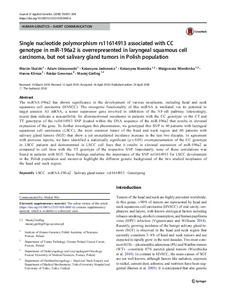Single nucleotide polymorphism rs11614913 associated with CC genotype in miR-196a2 is overrepresented in laryngeal squamous cell carcinoma, but not salivary gland tumors in Polish population
Katarzyna Kiwerska; Katarzyna Jaskiewicz; Adam Ustaszewski; Hanna Klimza; Marcin Skalski; Malgorzata Wierzbicka; Reidar Grenman; Maciej Giefing
Single nucleotide polymorphism rs11614913 associated with CC genotype in miR-196a2 is overrepresented in laryngeal squamous cell carcinoma, but not salivary gland tumors in Polish population
Katarzyna Kiwerska
Katarzyna Jaskiewicz
Adam Ustaszewski
Hanna Klimza
Marcin Skalski
Malgorzata Wierzbicka
Reidar Grenman
Maciej Giefing
SPRINGER HEIDELBERG
Julkaisun pysyvä osoite on:
https://urn.fi/URN:NBN:fi-fe2021042719273
https://urn.fi/URN:NBN:fi-fe2021042719273
Tiivistelmä
The miRNA-196a2 has shown significance in the development of various neoplasms, including head and neck squamous cell carcinoma (HNSCC). The oncogenic functionality of this miRNA is mediated via its potential to target annexin A1 mRNA, a tumor suppressor gene involved in inhibition of the NF-kappa B pathway. Interestingly, recent data indicate a susceptibility for aforementioned neoplasms in patients with the CC genotype vs the CT and TT genotypes of the rs11614913 SNP located within the DNA sequence of the miR-196a2 that results in elevated expression of the gene. To further investigate this phenomenon, we genotyped this SNP in 40 patients with laryngeal squamous cell carcinoma (LSCC), the most common tumor of the head and neck region and 60 patients with salivary gland tumors (SGT) that show a yet unexplained incidence increase in the last two decades. In agreement with previous reports, we have identified a statistically significant (p < 0.05) overrepresentation of the CC genotype in LSCC patients and demonstrated in LSCC cell lines that it results in elevated expression of miR-196a2 as compared to cell lines with the TT genotype of the respective SNP. Importantly, none of these correlations was found in patients with SGT. These findings underline the importance of the SNP rs11614913 for LSCC development in the Polish population and moreover highlight the different genetic background of the two studied neoplasms of the head and neck region.
Kokoelmat
- Rinnakkaistallenteet [19240]
